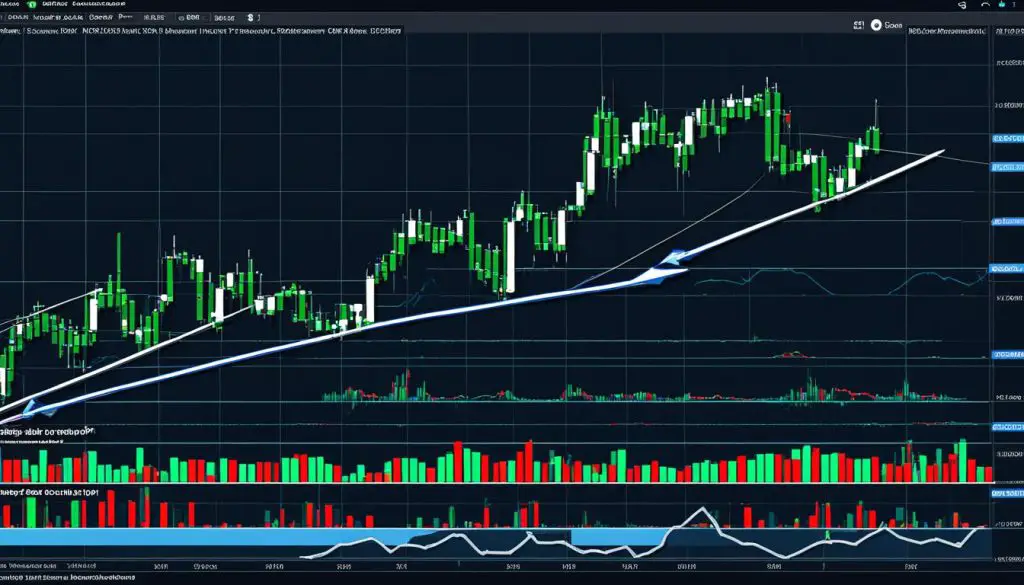Navigating the financial markets requires precision, foresight, and a solid understanding of market dynamics. The usage of a robust market forecast indicator is indispensable for traders who thrive on identifying the opportune moments to buy or sell. Excellence in this area translates directly to trading success, making the right tools fundamental for any serious investor.
Adopting a predictive market indicator equips you with the ability to decipher the subtle nuances of market behavior. Not just any market prediction tool, but those backed by thorough analysis and high accuracy can pivot the scale towards profitable outcomes. Let’s explore the indicators that seasoned traders rely on to stay ahead of the curve.
Understanding Market Forecast Indicators
Within the financial markets, the ability to anticipate price movement is invaluable. Market trend predictors offer traders this foresight, serving as a lighthouse amidst the choppy waters of market volatility. As both a financial forecasting tool and an economic indicator, these predictors are the keystones in the arch of trading strategies, providing structure and guidance to investors worldwide.
The Role of Market Predictive Indicators in Trading
The influence of market predictive indicators on trading can hardly be overstated. They deliver data-driven insights that inform traders on potential future price actions, helping to sculpt informed strategies that align with the anticipated movements of the market.
Types of Market Forecast Indicators
Market forecast indicators can be broadly categorized into two types: overlays and oscillators. Overlays such as moving averages and Bollinger Bands meld onto price charts, delineating trends and potential support or resistance levels. Oscillators, including the likes of stochastic oscillator, MACD, and RSI, instead visualize momentum by oscillating between specific value ranges, usually above or below a price chart.
Market Psychology and the Importance of Volume Data
A crucial aspect of market psychology, volume data reveals the intensity behind price movements and supplies traders with a broader perspective on market sentiment. Indicators like on-balance volume quantify the flow of volume in a positive or negative direction, thereby imparting clarity on the strength of trends and the conviction of market participants.
| Indicator | Type | Primary Function | Trading Application |
|---|---|---|---|
| Moving Averages | Overlay | Trend Identification | Spotting Trend Reversals |
| Bollinger Bands | Overlay | Volatility Measurement | Identifying Overbought/Oversold Conditions |
| Stochastic Oscillator | Oscillator | Momentum Analysis | Timing Entries and Exits |
| MACD (Moving Average Convergence Divergence) | Oscillator | Trend Momentum | Confirming Trend Changes |
| RSI (Relative Strength Index) | Oscillator | Momentum Oscillator | Spotting Divergences |
| On-Balance Volume | Volume Indicator | Volume Flow Tracking | Confirming Trend Strength |
The Essentials of a Market Trend Predictor
Within the realm of finance, the ability to anticipate market behavior is invaluable. Among the array of tools available to investors, the forecasting algorithm has proven to be a cornerstone of technical analysis. A market trend predictor does not merely serve as a reactive measure; it provides actionable insights. These insights pave the way for strategic decisions that can lead to substantial gains or the mitigation of potential losses.
Analyzing Trends with Technical Analysis Tools
Technical analysis tools are the navigational instruments guiding traders through the ever-changing tides of the financial markets. By analyzing past market data, investors can discern patterns that aid in predicting future price movements. The utilization of a robust forecasting algorithm is critical in scanning for indicators of momentum or reversals in market trends, offering a scientific approach to what once was considered an art form.
Overlay and Oscillator Indicators: A Fundamental Comparison
Understanding the nuance between overlay and oscillator indicators is pivotal in applying technical analysis effectively. Overlay indicators, such as moving averages and Bollinger Bands, coalesce seamlessly with price charts, providing a direct visual representation of trends and potential support or resistance levels. Oscillators, including the likes of RSI and MACD, oscillate within a defined range, signaling overbought or oversold conditions away from the core price graph. Such distinctions are critical, as these indicators lay the groundwork for discerning market sentiment and directing investment strategies.
| Indicator Type | Main Function | Typical Use-Case |
|---|---|---|
| Overlay Indicators | Visual Trend Identification | Identifying potential support and resistance levels with examples like Fibonacci retracement |
| Oscillator Indicators | Momentum Measurement | Gauging the strength of a trend and locating overbought/oversold conditions using tools such as Stochastic Oscillator |
The judicious application of market trend predictors grants investors the ability to not only follow but also forecast market movements. Enhanced by the precision of today’s forecasting algorithms, the quest for trading success is increasingly data-driven and analytically robust, setting a new standard in the financial forecasting domain.
Top Financial Forecasting Tools for Day Trading
Success in day trading is closely tied to the effective use of financial forecasting tools. Harnessing the predictive power of market indicators not only enhances decision-making but also fortifies one’s trading strategies. Let’s delve into a list of fundamental tools that offer the keen insight required by day traders:
- On-Balance Volume (OBV): This market forecast indicator interprets volume flow to predict changes in stock price.
- Accumulation/Distribution Line: It serves as a predictive market indicator by measuring the cumulative flow of money into and out of a stock.
- Moving Average Convergence Divergence (MACD): Renowned for pinpointing trend direction and momentum shifts.
- Relative Strength Index (RSI): This tool highlights potentially overbought or oversold conditions, alerting traders to impending trend reversals.
- Stochastic Oscillator: It compares a stock’s closing price to its price range over a specific period, offering insights into overbought or oversold states.
In the table below, we examine these indicators to offer a clearer understanding of their key functions and how they aid in market prediction:
| Indicator | Main Function | What It Signals | Common Usage |
|---|---|---|---|
| On-Balance Volume (OBV) | Momentum tracking via volume analysis | Potential price changes based on volume trends | Confirming trend direction with volume data |
| Accumulation/Distribution Line | Money flow measurement | Bullish or bearish trends | Identifying divergence that may signal reversals |
| Moving Average Convergence Divergence (MACD) | Identification of trend direction and momentum | Convergence or divergence of moving averages, indicating bullish or bearish outcomes | Trend following and identifying potential entry/exit points |
| Relative Strength Index (RSI) | Overbought/oversold condition analysis | Overbought or oversold conditions based on recent price changes | Determining momentum and possible price corrections |
| Stochastic Oscillator | Price momentum evaluation by comparing closing price to price range | Overbought or oversold conditions | Confirming potential trend reversals |
The quintessence of day trading lies not only in the ability to understand current market conditions but also in anticipating market movements before they occur. Utilizing these top predictive market indicators can afford traders the foresight needed to navigate the markets adeptly and with greater confidence. Make sure to always trade inline with the daily economic events.
Incorporating Market Forecast Indicator into Trading Strategy
For traders aiming to stay ahead of the curve, weaving market forecast indicators into their strategic tapestry can be a game-changer. These financial forecasting tools are far more than just trendy accessories in a trader’s toolkit; they are pivotal instruments that provide critical market insights. To navigate through the complex web of market prediction, it’s imperative to consider how these indicators can serve as the backbone of a sound trading methodology.
Using On-Balance Volume (OBV) for Trend Confirmation
The On-Balance Volume (OBV) stands tall as a trusted market prediction tool, providing traders with a clear line of sight into the undercurrents of market trends. Its utility lies in confirming whether the publicized trend is an accurate representation of market sentiment, making it an invaluable economic indicator. When the OBV aligns with price trends, traders can proceed with increased confidence in the robustness of their observations.
Momentum Tracking with the Average Directional Index
The Average Directional Index slices through the noise, presenting traders with the essence of market momentum. By measuring trend strength, the index reveals whether a particular movement has the endurance to continue or if it’s likely to wane, akin to a lighthouse guiding ships through foggy markets. Integrating the Average Directional Index into a trading strategy affords traders an analytical edge in forecasting market progressions.
Identifying Price Reversals with Aroon Oscillators
In the realm of market ebbs and flows, Aroon Oscillators function as vigilant sentries against abrupt price reversals. These indicators alert traders to the potential dawn of a new trend or the twilight of an existing one, often preempting noticeable shifts in market direction. The forewarning provided by Aroon Oscillators can be pivotal in adjusting strategies in time to mitigate risk and capitalize on emerging opportunities.
MACD as a Trend Direction and Momentum Signal
Perhaps the most versatile knight in the arsenal, Moving Average Convergence Divergence (MACD), serves a dual role. It not only indicates the direction but also gauges the momentum of market trends. As a composite financial forecasting tool, MACD’s insights allow traders to decipher the mood of the market, offering cues for both entry and exit points. Strategically, its use is tantamount to a harbor pilot guiding traders to navigate safely and profitably through trading channels.






